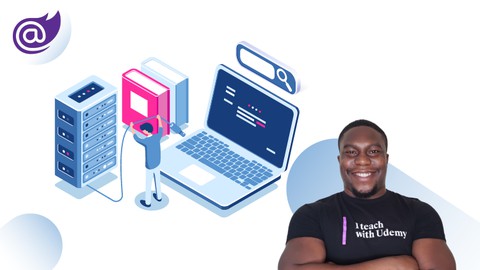
Complete Blazor (WASM & Server) and ASP.NET API Development
Complete Blazor (WASM & Server) and ASP.NET API Development, available at $84.99, has an average rating of 4.62, with 77 lectures, based on 1282 reviews, and has 14851 subscribers.
You will learn about Build Complete Data Driven .NET Core API From Scratch Build client side apps using Blazor Server and Blazor WebAssembly Learn Development with Blazor 6 / 8 How to Build RESTful APIs with proper practices Learn C# and Visual Studio Techniques Repository Pattern and Dependency Injection Use AutoMapper and Data Transfer Objects (DTOs) Interact with Database using Entity Framework Core Use NuGet Package Manager Manage and Track Changes using GitHub Asynchronous Programming Custom Logging using Serilog Use Swagger UI Documentation Deploy Web API to Microsoft Azure Deploy Blazor Applications to Microsoft Azure Use NSwag Studio This course is ideal for individuals who are Anyone who wants to learn REST API Development with .NET Core or Anyone who wants to learn Blazor Server Development or Anyone who wants to learn Blazor WebAssembly Development It is particularly useful for Anyone who wants to learn REST API Development with .NET Core or Anyone who wants to learn Blazor Server Development or Anyone who wants to learn Blazor WebAssembly Development.
Enroll now: Complete Blazor (WASM & Server) and ASP.NET API Development
Summary
Title: Complete Blazor (WASM & Server) and ASP.NET API Development
Price: $84.99
Average Rating: 4.62
Number of Lectures: 77
Number of Published Lectures: 74
Number of Curriculum Items: 77
Number of Published Curriculum Objects: 74
Original Price: $199.99
Quality Status: approved
Status: Live
What You Will Learn
- Build Complete Data Driven .NET Core API From Scratch
- Build client side apps using Blazor Server and Blazor WebAssembly
- Learn Development with Blazor 6 / 8
- How to Build RESTful APIs with proper practices
- Learn C# and Visual Studio Techniques
- Repository Pattern and Dependency Injection
- Use AutoMapper and Data Transfer Objects (DTOs)
- Interact with Database using Entity Framework Core
- Use NuGet Package Manager
- Manage and Track Changes using GitHub
- Asynchronous Programming
- Custom Logging using Serilog
- Use Swagger UI Documentation
- Deploy Web API to Microsoft Azure
- Deploy Blazor Applications to Microsoft Azure
- Use NSwag Studio
Who Should Attend
- Anyone who wants to learn REST API Development with .NET Core
- Anyone who wants to learn Blazor Server Development
- Anyone who wants to learn Blazor WebAssembly Development
Target Audiences
- Anyone who wants to learn REST API Development with .NET Core
- Anyone who wants to learn Blazor Server Development
- Anyone who wants to learn Blazor WebAssembly Development
Overview
Learn how to build a RESTful API using ASP.NET Core 6 / 7,and then consume it in a modern BlazorSingle Page Application. Along the way, we will review clean coding principles and patterns, RESTful Standards, logging tools, database development and management, and application testing and deployment strategies.
By the end of the course, we would have built a single-page application using Blazor (Server and WebAssembly)that will serve as a stand-alone client app, consuming and interacting with an API. We will look at handling authentication using JSON Web Token (JWT)and using this JWT to communicate with the API for all other operations that our app will support.
ASP.NET Coreis Microsoft’s modern, cross-platform framework for building enterprise-ready web applications. Its suite of frameworks allows us to develop RESTful APIs and now thanks to Blazor, build robust client apps to interact with our API.
Why Learn ASP.NET Core (.NET 6)
Microsoft .NET is the platform that drives the business technology of many of the top corporations in the United States and many other countries. It is the predominant technology used to drive enterprise-scale business technology. Companies have chosen .NET because of its proven scalability, reliability, and support.
The .NET language of choice to learn is C#, as it is among the most widely used languages today. It’s a general-purpose programming language that can handle almost any problem, from desktop to mobile to dynamic web applications. As such, there is a high demand across the world for .NET developers in a variety of industries, which means that more jobs are available for candidates with a foundation built upon .NET technologies.
Why Develop With Blazor?
The most popular JavaScript client-side web frameworks have been Angular, React, Vue and others. In this course, we keep it .NET by using Blazor, which is Microsoft’s response to that monopoly.
Blazorallows you to create a Single Page Application, on top of .NET Coreand continue coding in C# (without needing to flip between C# and JavaScript too much). Blazor apps are composed of reusable web UI components implemented using C#, HTML, and CSS. Both client and server code is written in C#, allowing you to share code and libraries.
Blazor WebAssembly or Blazor Server
Blazor can run your client-side C# code directly in the browser, using WebAssembly. Because it’s real .NET running on WebAssembly, you can re-use code and libraries from server-side parts of your application.
Alternatively, Blazor can run your client logic on the server. Client UI events are sent back to the server using SignalR– a real-time messaging framework. Once execution completes, the required UI changes are sent to the client and merged into the DOM
We will be exploring many intricacies of the Blazorlife-cycle, data flow, JavaScript Interoperability, and general development activities.
Deploy To Microsoft Azure Cloud
Azure Web App Service is key to deploying the API and Blazor Server Applications. We will also enlist the use of Azure SQLfor the Database to support our API.
Build A Strong Foundation in .NET Core Programming:
-
Build a fully data-driven REST Web API using cutting-edge technology
-
Build a Single Page Applicationclient-side UIusing Blazor Server AND Blazor WebAssembly
-
Connect to an existing Database using Entity Framework Core
-
Repository Patternand Dependency Injection
-
Progressive Web Applicationwith Blazor
-
Setup Logging using Serilog
-
Setup API documentation using SwaggerUI
-
Understand the RESTdesign principles
-
Understand C# 10 and .NET Core Web Syntax
-
Use NSwag to speed up API Client Development
-
Understand user Authentication using JWT (JSON Web Tokens)
-
Store JSON Web Tokensusing Local Browser Storage
-
Handle BlazorApplication User AuthenticationState
-
Consume REST Web API in BlazorApplication
-
Understand how to use Models, DTOs and AutoMapper
-
Manage Packages with NuGet Manager
-
Setup GitHubfor Source Control
-
Deploy Applications and Database to Microsoft Azure
PREREQUISITES
In order to take this course, you should have at least 3 months of experience programming in C#. If you need to strengthen your C# fundamentals, you can take my C# beginner course C# Console and Windows Forms Development with LINQ & ADO .NET.If you need to brush up on your web development skills, you may also review Introduction To Website Development Technologies to learn the fundamentals of HTML, CSS, and JavaScript.
Content and Overview
To take this course, you will need to have some knowledge of Object Oriented Programming, if not C#. Even if you have little exposure to the .NET development stack, this course is beginner-friendly and full of development tips.
This is a huge course. Over 16 hours of premium content, but smartly broken up to highlight a set of related activities based on each module in the application that is being built. We will also look at troubleshooting and debugging errors as we go along; implementing best practices; writing efficient logic and understanding why developers do things the way they do. Your knowledge will grow, step by step, throughout the course and you will be challenged to be the best you can be.
We don’t do things the perfect way the first time; that is different from the reality of writing code. We make mistakes and point them out and fix them around them. By doing this, we develop proficiency in using debugging tools and techniques. By the time you have finished the course, you will have moved around in Visual Studio and examined logic and syntax errors so much, that it will be second nature for you when working in the .NET environment. This will put your newly learned skills into practical use and impress your boss and coworkers.
The course is complete with working files hosted on GitHub, with the inclusion of some files to make it easier for you to replicate the code being demonstrated. You will be able to work alongside the author as you work through each lecture and will receive a verifiable certificate of completion upon finishing the course.
Clicking the Take This Course button could be the best step you could take towards quickly increasing your income and marketability! Also, remember that if you don’t think the course is worth what you spent, you have a full 30 days to get a no questions asked refund!
It’s time to take action!
See you in the course!
Course Curriculum
Chapter 1: Introduction
Lecture 1: Introduction
Chapter 2: Environment Configuration and Account Setup
Lecture 1: Install Visual Studio 2022 Community Edition
Lecture 2: IMPORTANT – .NET 8 Update
Lecture 3: Install SQL Server Express Edition
Lecture 4: Create a GitHub Account
Lecture 5: Install and Explore PostMan
Chapter 3: Project Setup and Configurations
Lecture 1: Create ASP.NET Core Web API Project
Lecture 2: *OPTIONAL* – Upgrade to .NET 7
Lecture 3: Tour of Project Structure and Files
Lecture 4: Configure Logging using Serilog
Lecture 5: CORS Configuration
Lecture 6: Review and Add Changes to GitHub
Chapter 4: Setup and Scaffold Database
Lecture 1: Create Database in SQL Server
Lecture 2: Scaffold Database
Lecture 3: *IMPORTANT* – Scaffold Database Error Fix
Lecture 4: Review and Add Changes to GitHub
Chapter 5: Setup Author API Controller and Functionality
Lecture 1: Section Overview
Lecture 2: Setup API Controller
Lecture 3: Setup AutoMapper and DTOs
Lecture 4: Add Logging with Serilog and Seq
Lecture 5: Review and Add Changes to GitHub
Chapter 6: Setup Book API Controller and Functionality
Lecture 1: Section Overview
Lecture 2: Setup API Controller
Lecture 3: Setup AutoMapper and DTOs
Lecture 4: Review and Add Changes to GitHub
Chapter 7: Configure Identity and JWT Authentication
Lecture 1: Section Overview
Lecture 2: Add Identity Core Libraries and Tables to API
Lecture 3: Add Custom Fields to User Table
Lecture 4: Seed Test Users and Roles
Lecture 5: Setup Authentication Controller
Lecture 6: Setup JSON Web Tokens (JWT) Authentication – Part 1
Lecture 7: Setup JSON Web Tokens (JWT) Authentication – Part 2
Lecture 8: Setup Controller and Action Authorizations
Lecture 9: Review and Add Changes to GitHub
Chapter 8: Create Blazor Server Client App
Lecture 1: Section Overview
Lecture 2: Create and Understand Blazor Project Structure
Lecture 3: Setup HTTP Client Using NSwag Studio
Lecture 4: Setup User Registration
Lecture 5: Setup User Login – Part 1
Lecture 6: Setup User Login – Part 2
Lecture 7: Review and Add Changes to GitHub
Chapter 9: Author Management Blazor UI
Lecture 1: Section Overview
Lecture 2: Setup Authors Index
Lecture 3: Extend HTTP Client
Lecture 4: Setup Create Author Component
Lecture 5: Setup Update Author Component
Lecture 6: Setup View Author Component
Lecture 7: Delete Author with JavaScript Interop
Lecture 8: Add Authorization Restrictions
Lecture 9: Review and Add Changes to GitHub
Chapter 10: Book Management Blazor UI
Lecture 1: Section Overview
Lecture 2: Setup Book Management Service Methods
Lecture 3: Setup Books Index Component (With Delete Functionality)
Lecture 4: Setup Create Book Component w/ File Upload – Part 1
Lecture 5: Setup Create Book Component w/ File Upload – Part 2
Lecture 6: Setup View Book Component
Lecture 7: Setup Update Book Component
Lecture 8: Review and Add Changes to GitHub
Chapter 11: Create Blazor WebAssembly Client App
Lecture 1: Blazor WebAssembly Introduction
Lecture 2: Tour Blazor WebAssembly Project
Lecture 3: Transferring Blazor Server Code to Blazor WebAssembly
Lecture 4: Progressive Web Application
Lecture 5: Review and Add Changes to GitHub
Chapter 12: UI and Architectural Considerations
Lecture 1: Implement Repository Pattern
Lecture 2: Virtualization
Lecture 3: Code Behind Component Files
Lecture 4: Section Source Code
Chapter 13: Deploy to Microsoft Azure
Lecture 1: Section Overview
Lecture 2: Setup Microsoft Azure Account
Lecture 3: Deploy API to Azure
Lecture 4: Deploy Blazor Server App
Lecture 5: Deploy Blazor WebAssembly App
Lecture 6: Section Review
Chapter 14: BONUS Section
Lecture 1: Bonus Lecture
Instructors
-
Trevoir Williams
Certified Trainer • Top-Rated Instructor • 450,000+ Students
Rating Distribution
- 1 stars: 9 votes
- 2 stars: 15 votes
- 3 stars: 108 votes
- 4 stars: 405 votes
- 5 stars: 745 votes
Frequently Asked Questions
How long do I have access to the course materials?
You can view and review the lecture materials indefinitely, like an on-demand channel.
Can I take my courses with me wherever I go?
Definitely! If you have an internet connection, courses on Udemy are available on any device at any time. If you don’t have an internet connection, some instructors also let their students download course lectures. That’s up to the instructor though, so make sure you get on their good side!
You may also like
- Best Emotional Intelligence Courses to Learn in March 2025
- Best Time Management Courses to Learn in March 2025
- Best Remote Work Strategies Courses to Learn in March 2025
- Best Freelancing Courses to Learn in March 2025
- Best E-commerce Strategies Courses to Learn in March 2025
- Best Personal Branding Courses to Learn in March 2025
- Best Stock Market Trading Courses to Learn in March 2025
- Best Real Estate Investing Courses to Learn in March 2025
- Best Financial Technology Courses to Learn in March 2025
- Best Agile Methodologies Courses to Learn in March 2025
- Best Project Management Courses to Learn in March 2025
- Best Leadership Skills Courses to Learn in March 2025
- Best Public Speaking Courses to Learn in March 2025
- Best Affiliate Marketing Courses to Learn in March 2025
- Best Email Marketing Courses to Learn in March 2025
- Best Social Media Management Courses to Learn in March 2025
- Best SEO Optimization Courses to Learn in March 2025
- Best Content Creation Courses to Learn in March 2025
- Best Game Development Courses to Learn in March 2025
- Best Software Testing Courses to Learn in March 2025






















